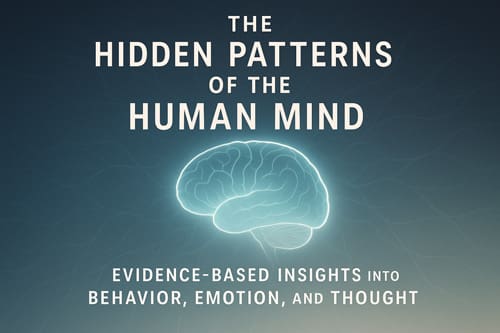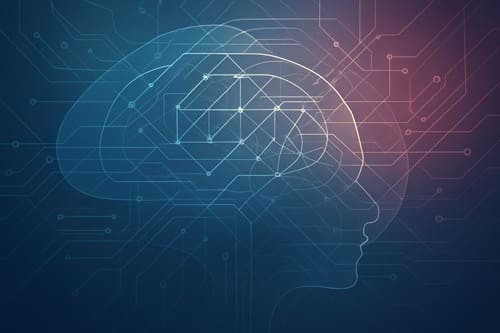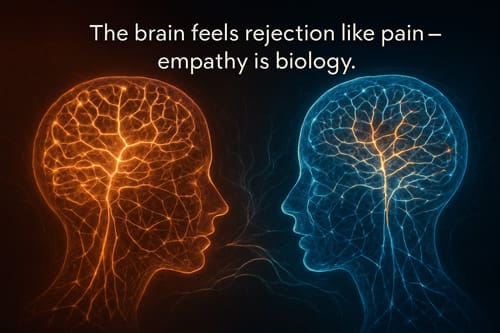The Hidden Patterns of the Human Mind Evidence-Based Insights into Behavior, Emotion, and Thought

Abstract
Human behavior is rarely as logical as we believe. Beneath our decisions, words, and gestures lies an intricate web of emotional impulses, cognitive shortcuts, and biological instincts. This paper explores key findings from contemporary psychology and neuroscience that illuminate how we think, feel, and connect with others. From self-talk to empathy, from emotional resilience to the shaping of memory, these insights reveal that the mind is both more fragile and more adaptable than most people imagine.
Introduction
For centuries, philosophers and scientists have tried to decode human behavior. Yet, many of our daily habits—why we procrastinate, connect, fall in love, or stay silent—are rooted in ancient neurological patterns rather than conscious reasoning. Today’s psychology offers a clearer lens: we are creatures of context, emotion, and chemical balance. The following synthesis brings together some of the most fascinating and well-supported findings in behavioral science, distilled into a human narrative that bridges academic research with lived experience.
1. The Language of the Mind
Talking to oneself, once dismissed as eccentric, is now recognized as a sign of cognitive control and self-regulation. Verbalizing thoughts activates regions of the brain involved in planning and goal maintenance, effectively transforming inner dialogue into mental coaching (Morin, 2018). Likewise, those who doodle during conversations often retain more information; small physical engagement helps anchor attention and improve recall (Andrade, 2010). These subtle behaviors demonstrate that the mind uses motion and language as tools to stabilize thought.
2. Emotion, Pain, and Connection
The human brain processes social rejection in the same neural circuits that register physical pain (Eisenberger & Lieberman, 2004). Emotional hurt, therefore, is not metaphorical—it’s biological. This overlap explains why isolation can feel like injury and why kindness can literally heal. Similarly, mirror neurons allow us to experience others’ pain and joy as if they were our own, serving as the foundation of empathy and social bonding (Rizzolatti & Sinigaglia, 2016).
Even small gestures matter: laughter between partners strengthens relational bonds, while affectionate physical touch releases oxytocin and reduces cortisol, lowering stress and enhancing trust (Ditzen et al., 2007).
3. The Paradox of Thought and Focus
Despite the modern glorification of multitasking, research shows it degrades performance and lowers temporary IQ, fragmenting attention across competing goals (Ophir, Nass, & Wagner, 2009). Focused monotasking remains the hallmark of high efficiency.
On the other hand, creativity often emerges when the brain relaxes its filters—during mild fatigue or daydreaming. When mental guardrails loosen, unexpected connections form, leading to breakthroughs that strict concentration might suppress (Baird et al., 2012).
The mind, it seems, thrives on both discipline and chaos—alternating between deliberate focus and unstructured exploration.
4. The Emotional Chemistry of Behavior
Emotion drives most decision-making long before logic intervenes. Neuroscience consistently shows that rational thought often serves to justify feelings rather than dictate them (Damasio, 1994). Smiling, even artificially, can elevate mood through facial feedback loops (Strack et al., 1988), while moderate exercise and music influence neurotransmitter levels that modulate emotion and attention.
A fast heartbeat can even be misread as attraction—an effect of physiological arousal known as misattribution (Dutton & Aron, 1974). The brain, in many cases, interprets chemistry as feeling, blurring the line between emotion and environment.
5. Self-Perception and Resilience
Most people underestimate their own attractiveness or worth, a distortion amplified by self-focus and social comparison. Others, however, tend to perceive us in fleeting, emotionally weighted snapshots—smiles, gestures, and tone—rather than the flaws we magnify in mirrors (Gilovich et al., 2000).
Resilience also manifests in unexpected ways: individuals who laugh at dark humor often display higher emotional stability and cognitive flexibility. Humor becomes a form of psychological armor, reframing pain into meaning (Samson & Gross, 2012). Similarly, those who forgive easily experience lower stress and reduced physiological reactivity, proving that compassion benefits both giver and receiver (Worthington & Scherer, 2004).
6. Memory and the Reconstruction of Reality
Memory is not a fixed record—it is a living document rewritten with each recall. Every act of remembering slightly alters the story (Loftus, 2003). Emotion plays a decisive role in this process: highly charged events—moments of love, fear, or grief—etch themselves more deeply into long-term memory than neutral ones.
Writing about one’s worries before sleep or setting goals on paper externalizes cognitive load, easing mental tension and improving both sleep quality and goal achievement (Pennebaker & Chung, 2011; Matthews, 2015). Ink, it turns out, is a powerful anchor for the mind.
7. Solitude, Empathy, and Social Connection
People who enjoy solitude are not antisocial—they often possess high emotional independence and deep introspection. Yet, humans remain wired for connection: brief interactions with strangers, such as casual conversation or shared laughter, measurably boost mood and well-being (Sandstrom & Dunn, 2014).
Chronic loneliness, conversely, weakens the immune system and accelerates biological aging (Cacioppo et al., 2015). Social connection, even in microdoses, functions as medicine—proof that the brain evolved for belonging as much as for survival.
8. The Mind’s Hidden Architecture
Beneath our awareness, the brain continuously edits experience, filters threats faster than opportunities, and biases attention toward the negative—a legacy of evolutionary survival (Baumeister et al., 2001). Yet, it also holds remarkable capacity for adaptation. Visualization, for instance, can rewire neural circuits nearly as effectively as physical practice (Decety, 1996).
Every act of imagination, focus, or forgiveness subtly reshapes the mind’s wiring. We are not passive observers of our own psychology—we are its active sculptors.

Conclusion 
What appears random in human behavior is, in truth, patterned and purposeful. Beneath our contradictions lie principles of survival, empathy, and adaptation that have evolved over millennia. The way we speak to ourselves, the emotions we hide, and the connections we form all reveal a deeper intelligence—one that is intuitive, embodied, and profoundly human. Understanding these patterns isn’t just an academic pursuit; it’s a path toward self-awareness, compassion, and balance in a complex world.

References:
-
Andrade, J. (2010). What does doodling do? Applied Cognitive Psychology, 24(1), 100–106.
-
Baird, B., Smallwood, J., Mrazek, M. D., Kam, J. W., Franklin, M. S., & Schooler, J. W. (2012). Inspired by distraction: Mind wandering facilitates creative incubation. Psychological Science, 23(10), 1117–1122.
-
Baumeister, R. F., Bratslavsky, E., Finkenauer, C., & Vohs, K. D. (2001). Bad is stronger than good. Review of General Psychology, 5(4), 323–370.
-
Cacioppo, J. T., Cacioppo, S., Capitanio, J. P., & Cole, S. W. (2015). The neuroendocrinology of social isolation. Annual Review of Psychology, 66, 733–767.
-
Damasio, A. R. (1994). Descartes’ Error: Emotion, Reason, and the Human Brain. Avon Books.
-
Decety, J. (1996). The neurophysiological basis of motor imagery. Behavioral Brain Research, 77(1–2), 45–52.
-
Ditzen, B., Neumann, I. D., Bodenmann, G., von Dawans, B., Turner, R. A., Ehlert, U., & Heinrichs, M. (2007). Effects of different kinds of couple interaction on cortisol and oxytocin secretion. Psychoneuroendocrinology, 32(5), 565–574.
-
Dutton, D. G., & Aron, A. P. (1974). Some evidence for heightened sexual attraction under conditions of high anxiety. Journal of Personality and Social Psychology, 30(4), 510–517.
-
Eisenberger, N. I., & Lieberman, M. D. (2004). Why rejection hurts: A common neural alarm system for physical and social pain. Trends in Cognitive Sciences, 8(7), 294–300.
-
Gilovich, T., Medvec, V. H., & Savitsky, K. (2000). The spotlight effect in social judgment: An egocentric bias in estimates of the salience of one’s own actions and appearance. Journal of Personality and Social Psychology, 78(2), 211–222.
-
Loftus, E. F. (2003). Our changeable memories: Legal and practical implications. Nature Reviews Neuroscience, 4(3), 231–234.
-
Matthews, G. (2015). Goal Setting and Performance Management. Routledge.
-
Morin, A. (2018). Inner speech and consciousness. American Journal of Psychology, 131(2), 173–192.
-
Ophir, E., Nass, C., & Wagner, A. D. (2009). Cognitive control in media multitaskers. Proceedings of the National Academy of Sciences, 106(37), 15583–15587.
-
Pennebaker, J. W., & Chung, C. K. (2011). Expressive writing: Connections to physical and mental health. Handbook of Health Psychology, 417–437.
-
Rizzolatti, G., & Sinigaglia, C. (2016). The mirror mechanism: A basic principle of brain function. Nature Reviews Neuroscience, 17(12), 757–765.
-
Samson, A. C., & Gross, J. J. (2012). Humour as emotion regulation: The differential consequences of negative versus positive humour. Cognition and Emotion, 26(2), 375–384.
-
Sandstrom, G. M., & Dunn, E. W. (2014). Social interactions and well-being: The surprising power of weak ties. Personality and Social Psychology Bulletin, 40(7), 910–922.
-
Strack, F., Martin, L. L., & Stepper, S. (1988). Inhibiting and facilitating conditions of the human smile: A nonobtrusive test of the facial feedback hypothesis. Journal of Personality and Social Psychology, 54(5), 768–777.
-
Worthington, E. L., & Scherer, M. (2004). Forgiveness is an emotion-focused coping strategy that can reduce health risks and promote health resilience: Theory, review, and hypotheses. Psychology & Health, 19(3), 385–405.

